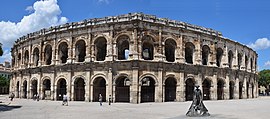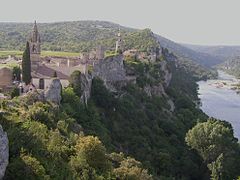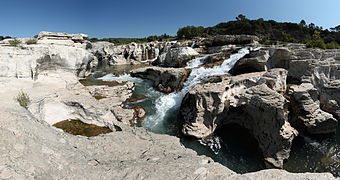Gard
Gard | ||
|---|---|---|
From top down, left to right: Pont du Gard, prefecture building in Nîmes, Cévennes and Arena of Nîmes | ||
|
Communes 351 | | |
| ^1 French Land Register data, which exclude estuaries, and lakes, ponds, and glaciers larger than 1 km2 | ||
Gard (French pronunciation: [ɡaʁ] ⓘ) is a department in Southern France, located in the region of Occitanie. It had a population of 748,437 as of 2019;[3] its prefecture is Nîmes.
The department is named after the river Gardon. In recent decades of the 21st century, local administration and French speakers have returned to the original Occitan name of the river, Gard (Occitan pronunciation: [gaɾ]). It is part of a revival of Occitan culture.
History
In classical times the Gard area was settled by Romans and their allies. They built the Via Domitia across the region in 118 BC. Centuries later, on 4 March 1790, Gard was one of the original 83 departments created during the French Revolution. It comprised the ancient province of Languedoc.
Originally this department was to include the canton of
During the middle of the nineteenth century the prefecture, traditionally a centre of commerce with a manufacturing sector focused on textiles, was an early beneficiary of railway development, becoming an important railway junction. Several luxurious hotels were built, and the improved market access provided by the railways also encouraged, initially, a rapid growth in wine growing. But many winegrowers were ruined when the vineyards were infected with phylloxera in 1872.
Geography
Gard is part of the region of Occitanie and is surrounded by the departments of Hérault, Lozère, Aveyron, Bouches-du-Rhône, Vaucluse and Ardèche. It has a short coastline to the south on the Mediterranean Sea. The highest point in the department is Mont Aigoual.
In the first quarter of the 21st century, the department has suffered serious flooding. The region has also been subject to some of the highest recorded temperatures in France's history as climate change alters summer heat.[4]
Demographics
Population development since 1791:
|
| |||||||||||||||||||||||||||||||||||||||||||||||||||||||||||||||||||||||||||||||||||||||
| ||||||||||||||||||||||||||||||||||||||||||||||||||||||||||||||||||||||||||||||||||||||||
| source:[5][6] | ||||||||||||||||||||||||||||||||||||||||||||||||||||||||||||||||||||||||||||||||||||||||
The inhabitants of Gard are called "Gardois". The most populous commune is Nîmes, the prefecture. As of 2019, there are eight communes that have more than 10,000 inhabitants each:[3]
| Commune | Population (2019) |
|---|---|
| Nîmes | 148,561 |
| Alès | 41,837 |
| Bagnols-sur-Cèze | 18,091 |
| Beaucaire | 15,906 |
| Saint-Gilles | 13,931 |
| Villeneuve-lès-Avignon | 12,216 |
| Vauvert | 11,492 |
| Pont-Saint-Esprit | 10,369 |
Politics
In the closely contested first round of the
Departmental Council
The President of the Departmental Council has been Françoise Laurent-Perrigot of the Socialist Party (PS) since 2021.
| Party | Seats | |
|---|---|---|
| The Republicans (LR) | 12 | |
| • | Socialist Party (PS) | 10 |
| Union of Democrats and Independents (UDI) | 7 | |
| • | French Communist Party (PCF) | 6 |
| • | Miscellaneous left (DVG) | 4 |
National Rally (FN) |
4 | |
| • | Europe Ecology – The Greens (EELV) |
2 |
| Miscellaneous right (DVD) | 1 | |
Members of the National Assembly
In the 2017 legislative election, Gard elected the following representatives to the National Assembly:
| Constituency | Member | Party | |
|---|---|---|---|
| Gard's 1st constituency | Françoise Dumas | La République En Marche!
| |
| Gard's 2nd constituency | Gilbert Collard | National Rally
| |
| Gard's 3rd constituency | Anthony Cellier | La République En Marche!
| |
| Gard's 4th constituency | Annie Chapelier | Ecology Democracy Solidarity | |
| Gard's 5th constituency | Olivier Gaillard | La République En Marche!
| |
| Gard's 6th constituency | Philippe Berta | MoDem | |
Tourism
Gard contains a part of the
.Gard is also home to the source of Perrier, a carbonated mineral water sold both in France and internationally on a large scale. The spring and facility are located just south-east of the commune of Vergèze.
See also
- Arrondissements of the Gard department
- Cantons of the Gard department
- Communes of the Gard department
References
- ^ "Répertoire national des élus: les conseillers départementaux". data.gouv.fr, Plateforme ouverte des données publiques françaises (in French). 4 May 2022.
- ^ "Téléchargement du fichier d'ensemble des populations légales en 2021". The National Institute of Statistics and Economic Studies. 28 December 2023.
- ^ a b Populations légales 2019: 30 Gard, INSEE
- ^ "France endures its hottest day ever as Europe swelters in heat wave". CNN. 28 June 2019.
- ^ "Historique du Gard". Le SPLAF.
- ^ "Évolution et structure de la population en 2016". INSEE.
- ^ "Résultats Gard - Présidentielle 2012 - 1er et 2nd tour". Le Monde.fr. Retrieved 11 April 2022.
External links
- . Encyclopædia Britannica. Vol. 11 (11th ed.). 1911.
- (in French) Prefecture website
- (in French) Departmental Council website
- (in French) Welcome to the Gard
- (in English) Welcome to the Gard
- (in French) Guide Gard







